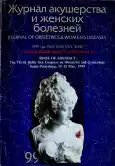Morphological changes in parenhyma of the liver of rats during long-term estrogen therapy
- Authors: Madej B.1, Maciejewski R.1, Radzikowska E.1
-
Affiliations:
- Medical University
- Issue: Vol 48, No 5S (1999)
- Pages: 106-106
- Section: Articles
- URL: https://bakhtiniada.ru/jowd/article/view/101197
- DOI: https://doi.org/10.17816/JOWD101197
- ID: 101197
Cite item
Full Text
Abstract
Objective. Oral steroid contraceptives were marketed in the United States in 1960s. They became one of the most widely used methods of reversible contraception in developing countries. Oral contraceptives are being used every day by more than 50 mln women around the world for the prevention of unwanted pregnancy as well as by women in replacement therapy. Estrogen replacement offers significant benefits to many postmenopausal women. The benefits and risks as they pertain to each individual patient should be reviewed with her in details. The aim of this study was to establish the influence of estrogen therapy on parenchyma of liver. The first descriptions of a relationship between Replacement Hormonal Therapy (RHT) use and the development of benign hepatic lesions were reported in early 1970s. Histopathologic diagnosis of benign liver tumors has been reported as focal nodular hyperplasia adenoma, solitary hyperplastic nodule and focal cirrhosis. Investigation of the possible relationship between HRT and liver cancer has provoked considerable controversy. Synthetic sex steroids are believed to potentate cholestasis, hypervascularity, microsomal enzyme induction.
Keywords
Full Text
##article.viewOnOriginalSite##About the authors
B. Madej
Medical University
Author for correspondence.
Email: info@eco-vector.com
Poland, Lublin
R. Maciejewski
Medical University
Email: info@eco-vector.com
Poland, Lublin
E. Radzikowska
Medical University
Email: info@eco-vector.com
Poland, Lublin
References
Supplementary files






